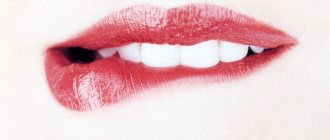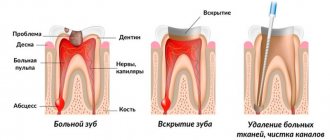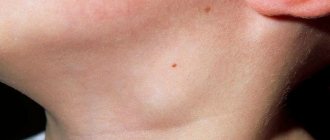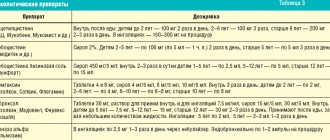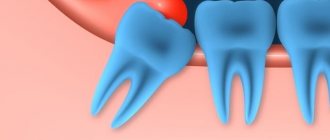Teething symptoms
The body reacts to the appearance of chewing organs with discomfort and pain.
- The baby cries, is capricious, puts everything in his mouth because his gums itch.
- Profuse salivation appears. This can provoke coughing, even with vomiting.
- Inflammation of the gums in a child is diagnosed.
- Often there is a symptom such as an allergy. Redness is visible in the area of the cheeks and chin.
- Children's temperature rises and their tummy becomes hard.
- The functioning of the gastrointestinal tract is disrupted. This manifests itself in the form of flatulence, diarrhea or irregular bowel movements. The child is constantly pushing.
- The body's defenses are reduced.
The same symptoms have different causes. Therefore, you should not make a diagnosis yourself. When warning signs are noticed, it is better to seek the services of a qualified doctor. Parents should not ignore discomfort in the tummy, excessive straining during bowel movements, regular colic, and the appearance of dense feces in the form of separate fragments.
How is the child examined?
In most cases, diarrhea with mucus does not require any specific examination7. The doctor assesses the child’s condition, examines him and, based on this, makes recommendations for treatment. To distinguish infectious causes of mucous diarrhea from non-infectious ones, the pediatrician prescribes laboratory tests and instrumental research methods4,7.
For a correct diagnosis, you should inform the doctor about the child’s eating habits, recently taken medications, and a tendency to allergies2.
Up to contents
Causes of constipation
The appearance of irregular bowel movements can be affected by the introduction of complementary foods at 4.5 - 6.5 months. The rapid addition of juices, purees, cereals and the transition to artificial nutrition strengthens the stool. The more aggressively and quickly the diet changes, the more often the baby experiences constipation during teething. After all, the digestive system reacts difficultly to this process. But the cause of the problem may not only be related to this.
- Because of the tooth mucous membranes and pain, the baby loses his appetite. Therefore, there is simply nothing for feces to form in the intestines.
- During this period, some enzymes are actively produced, which changes the functioning of the gastrointestinal tract.
- The child drinks little clean water, so there is not enough liquid for formed stool. It becomes hard and dry.
- When the first teeth appear, children begin to chew carefully and diligently, and food is better absorbed. This is a provoking factor for reducing stool mass.
Constipation during teething in a child occurs due to improper nutrition of the mother. When breastfeeding, mothers should not eat foods that have strengthening properties. Also, irregular stool occurs due to the passive behavior of the toddler due to a painful condition.
How and what to feed a baby when teething
The reaction to teeth depends on the individual characteristics of the child, his sensitivity to pain, nutrition and even the climate. Teething is often painful, causing children to refuse to drink or eat for a while. What to feed your baby when teething, as well as what are the first noticeable signs of teething and simple remedies that will help ensure more comfortable feeding and return to normal sleep, we will find out in a conversation with pediatrician Anastasia Anatolyevna Nikulina.
— Anastasia Anatolyevna, when babies start teething, how long does teething last?
— Children can “show off” their first central incisors at about six months. However, the first symptoms of teething in infants may appear a couple of months before the tooth appears. And it is advisable to see the beginning of the process in time to help the baby survive the pain. In most babies, symptoms of discomfort are detected three to four days before teething and usually disappear on the fourth day after the tooth comes out.
Obvious signs of teething in a baby:
- increased salivation, rash on the face and chest from constant wetting;
- swelling of the gums, their increased sensitivity when sucking;
- The toddler is irritable and whiny, capricious, does not accept the breast/bottle;
- the baby gnaws, bites objects, trying to relieve soreness in the mouth;
- The baby's sleep is disturbed and wakefulness appears at night.
— Teething discomfort is often mistaken for a cold or allergy. How to distinguish one condition from another?
— Teeth growth is a physiological stage, and, as a rule, it does not have negative consequences for the child’s health, despite frequent crying, fever, and excessive anxiety. It is possible to differentiate childhood illnesses based on knowledge of their characteristic signs.
Table. How to tell if your baby is teething
| Frequent manifestations | A tooth appears through the gum | The disease develops |
| Cough |
|
|
| Nasal discharge |
A saline solution is recommended for rinsing the spout. |
|
| Increase in body temperature to 38 °C |
|
|
| Rashes |
|
|
| Immunity weakens |
|
| Cough | A tooth appears through the gum
| The disease develops
|
| Nasal discharge | A tooth appears through the gum
A saline solution is recommended for rinsing the spout. | The disease develops
|
| Increase in body temperature to 38 °C | A tooth appears through the gum
| The disease develops
|
| Rashes | A tooth appears through the gum
| The disease develops
|
| Immunity weakens | The disease develops
|
— Parents are often concerned that their children are not eating enough. Are a baby's first teeth and decreased weight gain related?
— Poor appetite is an alarming symptom that occurs against the background of teeth moving and pressure on aching gums during feeding. The baby does not attach well to the breast, pushes out the nipple and receives less nutrition, which leads to a cessation of weight gain. It is better to simply temporarily switch to a free feeding regime, but not to force feed the baby.
Poor appetite in an infant may be accompanied by the following behavioral changes:
- complete or partial refusal of breast/bottle;
- constant whims when feeding with body writhing;
- increased desire to put something in the mouth followed by refusal to eat due to increased discomfort and itching in the gums;
- loss of interest in solid foods, especially in children on a mixed diet.
After the tooth breaks through the gum, the inflammation goes away and the appetite is completely restored. Therefore, you should not worry about your child’s reluctance to eat. The baby can get the required amount of vitamins through breast milk or formula. The main thing is not to skip two meals in a row.
— What if the child often refuses to suck the breast or pacifier?
“Parents need to be patient. An inflammatory process in the mouth - which means nights without sleep and a moody mood - reduces appetite. Any touching of the gums is accompanied by discomfort, so the baby does not want to suck. In such a situation, force feeding is useless. But even if the child misses two or three feedings per day, nothing bad will happen, everything will get better soon. When he gets very hungry, he will still take the breast or bottle and will definitely eat.
— A restless baby is waiting for support - how to soothe itching and inflammation of the gums?
— Teeth do not appear before three months, and sometimes a “dental holiday” in the family is celebrated closer to a year. The parents' task is not to miss the moment the tooth comes out in order to facilitate the process.
Teether-pacifier
- Given with the appearance of the first incisor for scratching the outside of the jaw. The itching subsides as teeth grow along the edges of the mouth. It is better to look for a wide pacifier (it is so convenient to reach hard-to-reach places in the oral cavity) with a narrow handle-limiter (does not interfere with the grip and prevents the pacifier from being swallowed too deeply).
Materials:
|
|
|
Sippy cup
— Teething is accompanied by a strong secretion of saliva, therefore, in order to normalize the water balance, plenty of drinking is often given from a convenient sippy cup. Its spout is made of rubber, and the valve does not allow liquid to leak. In addition, convenient holders prevent the bottle from slipping out of the baby's hands. Children are delighted with this “toy” and drink from a beautiful bottle with great diligence.
Pain reliever, gum gel
- Your doctor will advise you on the best solution. A number of medications to relieve inflammation and soothe gums include lidocaine. But there is no clear dosage for them, and the baby may swallow the medicine. Therefore, when treating gums when a tooth is cutting, lidocaine can lead to intoxication of a small organism and cause serious undesirable consequences.
| Spray/gel with lidocaine dangerous, limited use | Homeopathy inappropriate, safety and effectiveness of drugs have not been proven | Pharmaceutical preparations with belladonna especially dangerous, contraindicated | Non-steroidal drugs for fever are allowed, but their abuse is unsafe for the gastrointestinal tract | Gels based on medicinal plant extracts most safe and effective |
Rules for using gels for pain in teething syndrome:
- at the first concern of the child, a teether and a sippy cup are first given, a circular massage of the gums is done from the wings of the nose to the corners of the mouth;
- the product is used only in case of severe discomfort;
- apply a thin layer up to 3-4 times a day, strictly following the instructions;
- manipulation is performed with a clean finger, accompanied by a circular massage;
- It is preferable to lubricate the gums after feeding and at night;
- Under no circumstances should you allow your baby to chew on a tube of gel.
— Anastasia Anatolyevna, what to feed and how to feed the child when teeth are being cut - do you need to follow a schedule, give the baby something to drink, heat up food? And what is better to give to a child: baby formula/puree soup/vegetable puree? Should I continue breastfeeding?
— When teeth are being cut, it is important to temporarily move away from a clearly planned feeding regimen. It is better to offer your baby breast or formula milk on demand. Everything will soon return to normal and return to the order that developed during life without teeth.
It is preferable not to force the baby to eat thick foods. It is better to prepare liquid, pureed, light meals, and also not to introduce new complementary foods, do not give stale bread or cookies, in order to eliminate the risk of choking on crumbs. The temperature of the food should correspond to the temperature of the child’s body, so as not to worsen the baby’s condition and he does not lose the desire to eat. In case of hyperthermia and drooling, it is advisable to give the baby water.
— Do breastfed and bottle-fed babies experience the same painful condition when a tooth comes out?
— It has been observed that breastfed children tolerate the appearance of teeth more easily. Mother’s breasts are not only a source of complete and healthy food, but also a bioregulator of the emotional state, a way to calm down. Mothers whose babies literally “hang on their chest” observe that periods of prolonged feeding coincide with the appearance of dental cusps.
You need to show extra attention to a bottle-fed baby - hold him in your arms more often, fall asleep with him, spend sleepless nights next to him - fortunately, the tooth comes out completely in just 3-4 days (in the worst case, in a week).
— Do baby formulas have any effect on the baby when teeth are being cut?
— The best food for a newborn is, of course, breast milk. But there is no tragedy in transferring a child to artificial or mixed feeding if it is really necessary. This decision is made by the mother together with the pediatrician.
Fortunately, now there are alternatives to breast milk, and among them are MAMAKO® Premium infant formulas. They have an excellent composition and pleasant taste. One of their main advantages is the base of goat’s milk, which is closer in composition to breast milk than cow’s milk. The peculiarities of the protein component of goat mixtures make them easier to digest.
The eruption of the first teeth through soft, tender gums can cause the child to be whimsical when feeding. But the basic milk nutrition is preserved, and pureed complementary foods will make it easier to eat when there is soreness in the mouth. Also, the growth of teeth will bring less trouble if you pay more attention to the baby, communicate gently with him, distract him by singing or playing. It is important to massage the gums and offer the baby teethers. On the recommendation of a doctor, in case of intense pain, ointments and gels can be used to calm the baby and help teeth break through.
Pediatrician Anastasia Anatolyevna Nikulina
*The ideal food for an infant is mother's milk. WHO recommends exclusive breastfeeding for the first 6 months. MAMAKO® supports this recommendation. Before introducing new foods into your baby’s diet, consult a specialist.
How to help your baby
All therapeutic procedures must be prescribed by a doctor. Self-treatment is dangerous for the health of the baby. Those recipes offered by traditional healers may not be suitable for a newborn baby. Pharmaceutical preparations for children are available in the form of pleasant-tasting syrups. Kids don't refuse them. By turning to pediatric dentistry, parents can be confident in the success of the therapy. When the symptoms of the disease begin to subside, you should not stop taking the medications. This is done with the doctor's permission.
Natural laxatives include fruit purees made from fresh apples or apricots. They are baked in the oven, peeled from the rough crust, and ground. This supplement is usually allowed to be introduced into the diet in small portions from 4.5 months. If the intestines “like” complementary foods, the dose is gradually increased. The pediatrician may prescribe mild sedatives. After all, the nervous system takes an active part in the formation of units.
The mother of the baby should also follow the diet. She can eat dried apricots, prunes, and limit starchy dishes from rice, pasta, and potatoes. Flour products should be consumed with stewed vegetables. After all, everything that a mother eats enters the newborn’s body with her milk. For children in this condition, play activities in the form of moving their legs, arms, and lightly stroking their tummy are useful. When artificial feeding, you need to replace wheat and rice mixtures with buckwheat or oatmeal. A special teether with rough spikes will calm the nervous system, which reduces itching of the gums.
Constipation in infants when introducing complementary foods
The introduction of complementary foods, that is, the transition to a qualitatively new type of food, often causes constipation, even if previously everything was in order with the baby’s digestion. Complementary feeding products are recommended to be introduced into children's diets in addition to breast milk or formula from 4 to 6 months. Errors in introducing complementary foods can cause constipation in a baby:
- If complementary foods are introduced to a baby before 4 months, his digestion will not yet cope with other products other than breast milk or its substitutes.
- If complementary foods are introduced on time, but the consistency of the food is too thick, this can also cause constipation. Dense food will have difficulty moving through the still immature intestines. Of course, it’s difficult to make pureed zucchini or broccoli too thick, but with porridge it’s quite possible to miss the mark. Make sure that at the beginning of introducing complementary foods, the porridge is no thicker in consistency than liquid sour cream, and only then gradually transfer the baby to thicker food.
- Constipation can be caused by eating rice porridge as a first food if the child is prone to constipation. For a baby with a dense build, especially if he has stool retention, it is worth choosing vegetables to start complementary feeding. The best porridges for first feeding are buckwheat or corn. Do not forget that porridge at the beginning of complementary feeding should be dairy-free and consist of one type of cereal.
- With the introduction of complementary foods, the baby begins to need additional fluid. Offer him baby water in a bottle, cup or sippy cup throughout the day. Let him drink at least a sip. During the day, the volume of additional liquid should be approximately equal to what the baby eats in one feeding, this is about 150 - 200 ml. If water does not enter the baby’s body additionally, it will be absorbed, including from stool, which will become denser and dryer.
Infant digestion
A newborn is constantly in a state of adaptation to new living conditions. Its organs and systems continue to develop, and the physiological mechanisms of defecation are also improved.
In an adult, the retention of feces in the rectum is ensured by involuntary and voluntary, that is, subject to the will, contractions of its muscles - the sphincters.
The urge to defecate occurs when stool comes into contact with the lower intestine. An adult is able to control the urge, but a newborn child is not.
The milk enters the stomach and triggers a gastrointestinal reflex, generating a wave of peristalsis throughout the gastrointestinal tract. Feces fall into the rectum and cause the urge to defecate. Not realizing that the conditions for defecation are, to put it mildly, unsuitable, the baby draws in his legs and strains. Emptying your bowels makes room for more food.
The frequency of stool in a newborn often coincides with the frequency of feedings, but it can be twice a day3. The feces have a yellow or yellow-brown color, sometimes with a greenish tint, a mushy consistency mixed with foam and inclusions reminiscent of cottage cheese, and the smell of sour milk.
Starting at about 2 months, the frequency of stools begins to gradually decrease. By the time complementary foods are introduced (by 4-6 months), most infants have bowel movements 2 times a day, and some - once every 2 days3. The feces thicken and take on a sausage shape - this is what all small children should have.
Up to contents
Treatment
Treatment of diarrhea in a child should be carried out by a specialized specialist - a pediatrician or pediatric gastroenterologist. Only a doctor can adequately assess the severity of the patient’s condition and prescribe rational therapy.
If the disease is mild, the child is given more fluids to drink to quickly make up for the deficiency. If severe dehydration develops, hospitalization and intravenous saline solutions will be required3,7.
Diet therapy
In order for intestinal function to recover faster, it is important to monitor the child’s nutrition. If the diarrhea is mild and there are no signs of intoxication, in older children the amount of food should be reduced by 15-20%. The food must be well prepared; it is better to serve the dish pureed or mashed. From 3-5 days you can return to your previous diet. With moderate diarrhea, in the first days the amount of food is reduced by 20-30%, and over the course of 4-6 days they gradually return to the usual menu14.
It is advisable not to consume foods that increase diarrhea. Food containing soft fiber should be added to the menu14.
Diet for diarrhea with mucus in a child14
| Products to exclude | Recommended Products |
|
|
Up to contents



